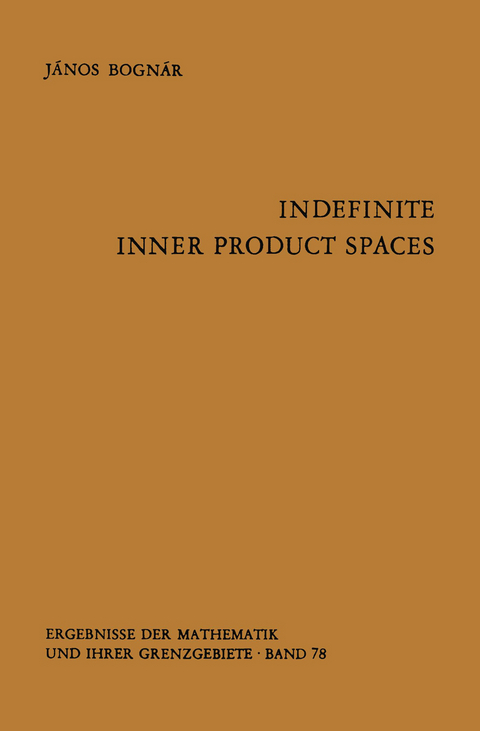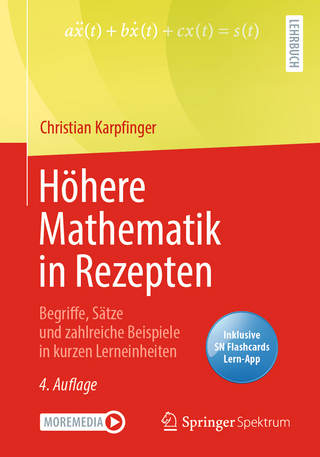
Indefinite Inner Product Spaces
Springer Berlin (Verlag)
978-3-642-65569-2 (ISBN)
I. Inner Product Spaces without Topology.- 1. Vector Spaces.- 2. Inner Products.- 3. Orthogonality.- 4. Isotropic Vectors.- 5. Maximal Non-degenerate Subspaces.- 6. Maximal Semi-definite Subspaces.- 7. Maximal Neutral Subspaces.- S. Projections of Vectors on Subspaces.- 9. Ortho-complemented Subspaces.- 10. Dual Pairs of Subspaces.- 11. Fundamental Decompositions.- Notes to Chapter I.- II. Linear Operators in Inner Product Spaces without Topology.- 1. Linear Operators in Vector Spaces.- 2. Isometric Operators.- 3. Symmetric Operators.- 4. Cayley Transformations.- 5. Principal Vectors of Cayley Transforms.- 6. Pairs of Inner Products: Semi-boundedness.- 7. Pairs of Inner Products: Sign.- 8. Plus-operators.- 9. Pesonen Operators.- 10. Fundamental Projectors.- 11. Fundamental Symmetries. Angular Operators.- Notes to Chapter II.- III. Partial Majorants and Admissible Topologies on Inner Product Spaces.- 1. Locally Convex Topologies on Vector Spaces.- 2. Partial Majorants. The Weak Topology.- 3. Metrizable Partial Majorants.- 4. The Polar of a Normed Partial Majorant.- 5. Admissible Topologies.- 6. Orthogonal Companions and Admissible Topologies.- 7. Projections and Admissible Topologies.- 8. Intrinsic Topology.- 9. Projections and Intrinsic Topology.- Notes to Chapter III.- IV. Majorant Topologies on Inner Product Spaces.- 1. Majorants.- 2. Majorants and Metrizable Partial Majorants.- 3. Orthonormal Systems.- 4. Minimal Majorants.- 5. Majorants and Decomposability.- 6. Decomposition Majorants.- 7. Invariant Properties of E+ and E-.- 8. Subspaces of Spaces with a Hilbert Majorant.- Notes to Chapter IV.- V. The Geometry of Krein Spaces.- 1. Krein Spaces.- 2. Krein Spaces as Completions.- 3. Subspaces.- 4. Maximal Semi-definite Subspaces.- 5. Uniformly Definite Subspaces.- 6.Non-uniformly Definite Subspaces.- 7. Maximal Uniformly Definite Subspaces.- 8. Regular and Singular Subspaces.- 9. Alternating Pairs.- 10. Dissipative Operators in Hilbert Space.- Notes to Chapter V.- VI. Unitary and Selfadjoint Operators in Krein Spaces.- 1. Preliminaries.- 2. The Adjoint of an Operator.- 3. Isometric Operators.- 4. Unitary and Rectangular Isometric Operators.- 5. Spectral Properties of Unitary Operators.- 6. Selfadjoint Operators.- 7. Cayley Transformations.- 8. Unitary Dilations.- Notes to Chapter VI.- VII. Positive Operators and Plus-operators in Krein Spaces.- 1. Positive Operators.- 2. Operators of the Form T*T.- 3. Uniformly Positive Operators.- 4. Plus-operators.- 5. Strict Plus-operators.- 6. Doubly Strict Plus-operators.- Notes to Chapter VII.- VIII. Invariant Semi-definite Subspaces of Linear Operators in Krein Spaces.- 1. Fundamentally Reducible Operators.- 2. Invariant Positive Subspaces of Plus-operators.- 3. Invariant Semi-definite Subspaces of Unitary and Selfadjoint Operators.- 4. Quadratic Pencils of Operators in Hilbert Space.- 5. Quadratic Operator Equations in I-Iilbert Space.- 6. Spectral Functions.- Notes to Chapter VIII.- IX. Pontrjagin Spaces and Their Linear Operators.- 1. The Spaces ?k· Positive Subspaces.- 2. Closed Subspaces.- 3. Isometric Operators: Continuity.- 4. Isometric and Symmetric Operators: Number and Length of Jordan Chains.- 5. Proof of Theorem 4.3.- 6. Regular Symmetric Extensions.- 7. Invariant Positive Subspaces: Existence.- 8. Invariant Positive Subspaces: Uniqueness.- 9. Common Invariant Positive Subspaces for Commuting Operators.- Notes to Chapter IX.- Index of Terms.- Index of Symbols.
| Erscheint lt. Verlag | 11.11.2011 |
|---|---|
| Reihe/Serie | Ergebnisse der Mathematik und ihrer Grenzgebiete. 2. Folge |
| Zusatzinfo | X, 226 p. |
| Verlagsort | Berlin |
| Sprache | englisch |
| Maße | 152 x 229 mm |
| Gewicht | 353 g |
| Themenwelt | Mathematik / Informatik ► Mathematik ► Algebra |
| Schlagworte | Equation • Field • Finite • Function • Geometry • Invariant • Mathematica • Product Spaces • Produkttopologie • Proof • quadratic form • Spaces • Theorem • Topology • Transformation • Vector Space |
| ISBN-10 | 3-642-65569-6 / 3642655696 |
| ISBN-13 | 978-3-642-65569-2 / 9783642655692 |
| Zustand | Neuware |
| Informationen gemäß Produktsicherheitsverordnung (GPSR) | |
| Haben Sie eine Frage zum Produkt? |
aus dem Bereich


